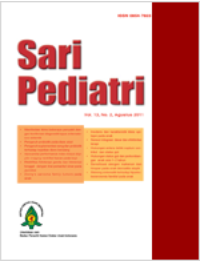Fusi Gen Translocation Ets Leukemia-Acute Myeloid Leukemia 1 (Tel-Aml1) Sebagai Faktor Prognosis pada Leukemia Limfoblastik Akut Anak
Sari
Kata Kunci
Teks Lengkap:
PDFReferensi
Pui CH, Sandlud JT, Pei D. Results of therapy for acute lymphoblastic leukemia in black and white children. JAMA 2003;290:2001-7.
Friedman AM, Weinstein HJ, The Role of Prognostic Features in the Treatment of Childhood Acute Lymphoblastic Leukemia. The Oncologist 2000;5:321-328.
Cline, M.J. The molecular basis of leukemia (review article). NEJM 2004;330:328-36.
Cleary ML. Ongogenic conversion of transcription factors by chromosomal translocation. Cell 1991; 66:1-3.
Rubnitz JE, Crist, WM. Molecular genetics of chilhood cancer: Implications for pathogenesis, diagnosis, and treatment. Pediatrics 1997;100:101-08.
Korsmeyer SJ. Chromosomal translocations in lymphoid malignancies reveal novel proto-oncogenes. Annu Rev Immunol 1992;10:785-807 (Medline).
Pui CH, Evans. Acute lymphoblastic leukemia, Narrator Engl J Med 2004;339:605-15.
Heerema NA, Sather HN, Senselm MG, Uckun FM. Frequency and clinical significance of cytogenetic abnormalities in pediatric T-lineage acute lymphoblastic leukemia: a report from the children’s cancer group. J of Clin Oncol 1998;16:1270-8.
Seeger K, Adams HP, Buchwald D, Henze G. TEL-AML1 fusion transcript in relapsed childhood acute lymphoblastic leukemia. The Berlin-Frankfurt-Munster Study Group. Blood 1988;91:1716-22.
Diakos C, Krapf G, Gerner C, Gruemayer RP. RNAi-mediated silencing of TEL-AML1 reveals a heat-shock protein–and survivin-dependent mechanism for survival. Blood 2007;109:2607-10.
Brisco MJ, Sykes PJ, Dolman G, Morley AA. Effect of the Philadelphia chromosome on minimal residual disease in acute lymphoblastic leukemia [see comments]. Leukemia 1997;11:1497.
Pui CH, Carroll AJ, Raimondi SC, Behm FG. Clinical presentation, karyotypic characterization and treatment outcome of childhood acute lymphoblastic leukemia with a near-haploid or hypodiploid less than 45 line. Blood 1990;75:1170-7.
Shurtleft SA, Buijs A, Behm FG, Rubnitz JE, Raimondi SC, Hancock ML. TEL/AML1 fusion resulting from a cryptic t(12;21) is the most common genetic lesion in pediatric ALL and defines a subgroup of patients with an excellent prognosis. Leukemia 1995;9:1985-9.
Whitehead VM, Vuchich MJ, Lauer SJ. Accumulation of high levels of methotrexate polyglutamates in lymphoblasts from children with hyperdiploid (greater than 50 chromosomes) B-lineage acute lymphoblastic leukemia: a Pediatric oncology group study. Blood 1992;80:1316-23.
Zuna. The role of TEL and AML1 genes in the pathogenesis of hematologic malignancies. Cas Lek Cesk 2001;140:131-7.
McLean TW, Ringold S, Neuberg D, Stegmaier K, Tantravahi R, Ritz J. TEL/AML-1 dimerizes and is associated with a favorable outcome in childhood acute lymphoblastic leukemia. Blood 1996;88:4252-8.
Borkhardt A, Cazzaniga G, Viehmann S, Valsecchi MG, Ludwig WD, Burci L. Incidence and clinical relevance of TEL/AML 1 fusion genes in children with acute lymphoblastic leukemia enrolled in the Germans and Italian multicenter therapy trials. Blood 1997;90: 571-7.
Cayuela JM, Baruchel A, Orange C, Madani A, Auclerc MF, Daniel MT. TEL-AML1 fusion RNA as a new target to detect minimal residual disease in pediatric B-cell precursor acute lymphoblastic leukemia. Blood 1996;88:302.
Stams WAG, Boer ML, Beverloo HB, Pieters R. Sensitivity to L-asparaginase is not associated with expression levels of asparagine synthetase in t(12;21)+ pediatric ALL. Blood, 2003;101:2743-7.
Krejci O, Starkova J, Otova B, Trka J. Upregulation of asparagine synthetase fails to avert cell cycle arrest induced by L-asparaginase in TEL/AML1-positive leukaemic cells. Leukemia 2004;8:434-41.
Stams WAG, Den Boer ML, Holleman A, Pieters R. Asparagine synthetase expression is linked with L-asparaginase resistance in TEL-AML1–negative but not TEL-AML1–positive pediatric acute lymphoblastic leukemia. Blood 2005;105:4223-5.
Appel LM, Den Boer ML, Meijerink JPP, Veerman AJP, Reniers NCM, Pieters R. Up-regulation of asparagine synthetase expression is not linked to the clinical response to L-asparaginase in pediatric acute lymphoblastic leukemia. Blood 2006;107:4244-9.
Uckun FM, Pallisgaard N, Hokland P, Heerema N. Expression of TEL-AML1 fusion transcript and response to induction therapy in standar risk acute lymphoblastic leukemia. Leuk Lymphoma 2001;42:41-56.
Madzo J, Zuna J, Muzikova K, Trka J. Slower molecular response to treatment predict poor outcome in patients with TEL/AML1 positive acute lymphoblastic leukemia: prospective real-time quantitative reverse trabscriptase-polymerase chain reaction study. Cancer 2003;97:105-13
Mosad E, Hamed HB, Bakry RM, Ezz-Eldin AM, Khalifa NM. Persistence of TEL-AML1 fusion gene as minimal residual disease has no additive prognostic value in CD 10 positive B-acute lymphoblastic leukemia: a FISH study. J Hematol Oncol 2008;1:17
Ma SK, Wan TS, Cheuk AT, Chan LC. Characterization of additional gentic events in childhood acute lymphoblastic leukemia with TEL/AML1 gene fusion: a molecular cytogenetic study. Leukemia 2001;15:1442-7.
Mikhail FM, Serry KA, Hatem N, Nucifora G. AML1 gene ever-expression in childhood acute lymphoblastic leukemia. Leukemia 2002;16:658-68.
Rothman R, Trakhtenbrot L, Bielorai B, Toren A. Co-existensi of multiple subclones in TEL-AML1 at diagnosis of acute lymphoblastic leukaemia in association with submicroscopic deletion of AML1. Br J Haematol 2005;129:491-8.
Gandemer V, Rio AG, Tayrac M, Galibert MD. Five distinct biological processes and 14 differentially expressed genes characterize TEL/AML1-positive leukemia. BMC Genomics 2007;8:385.
DOI: http://dx.doi.org/10.14238/sp10.6.2009.404-9
Refbacks
- Saat ini tidak ada refbacks.
##submission.copyrightStatement##
##submission.license.cc.by-nc-sa4.footer##
Email: editorial [at] saripediatri.org


Sari Pediatri diterbitkan oleh Badan Penerbit Ikatan Dokter Anak Indonesia
Ciptaan disebarluaskan di bawah Lisensi Creative Commons Atribusi-NonKomersial-BerbagiSerupa 4.0 Internasional.




